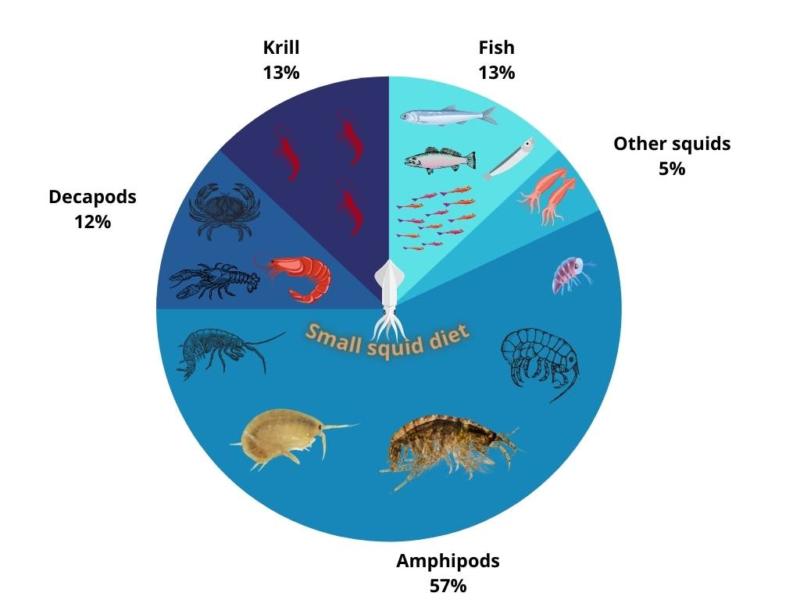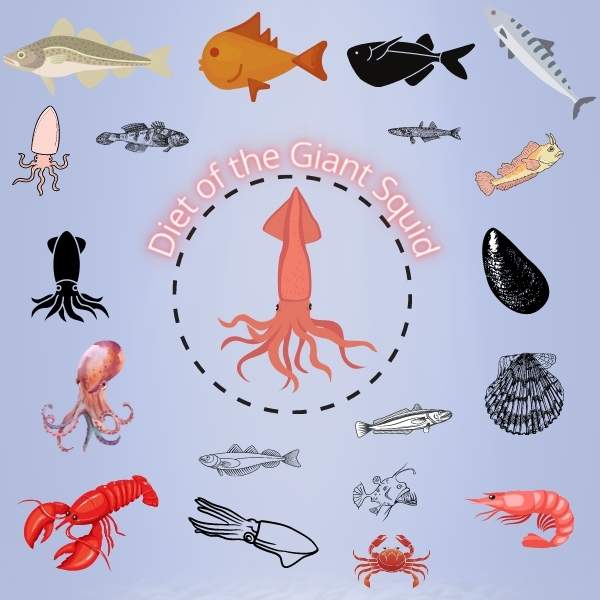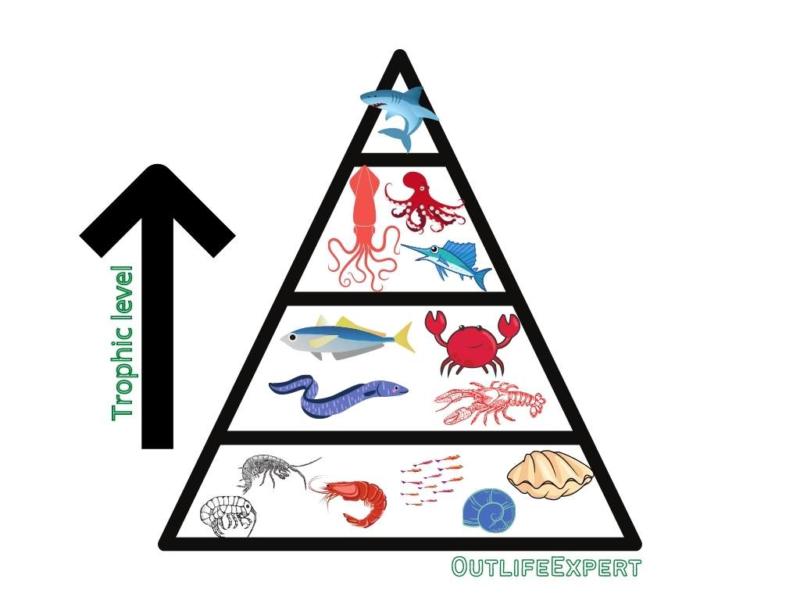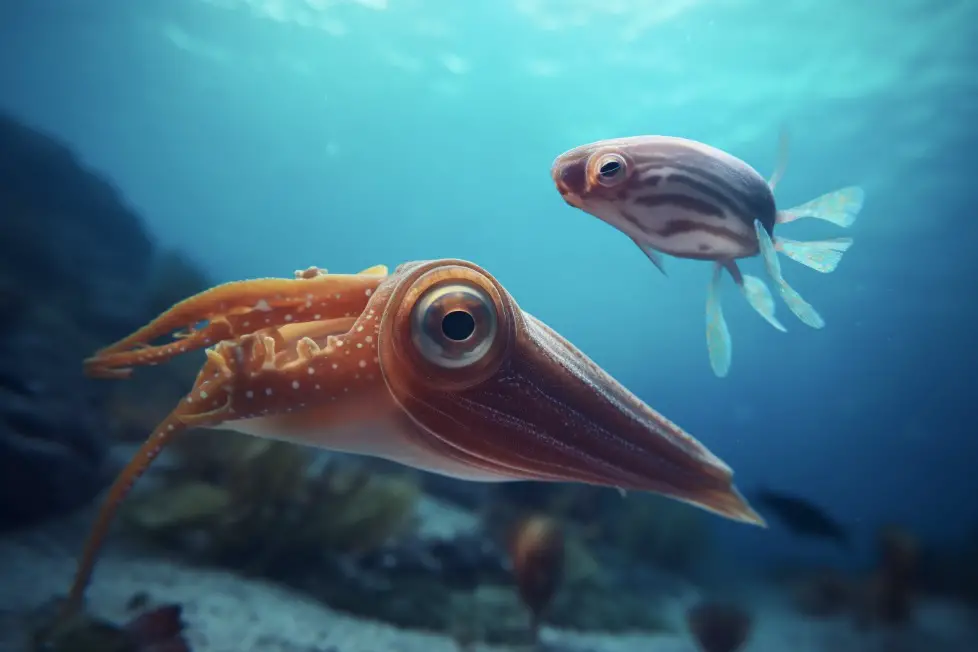Squid are fascinating creatures that are known for their lightning fast movements and their ability to camouflage themselves. But have you ever wondered what they eat?
Squid are known to prey on a variety of fish species, including anchovies, sardines, mackerel, and herring. Their diet also includes crustaceans, mollusks, and other cephalopods.
However, one type of prey that they particularly enjoy is other fish. In this blog post, we will cover some of the most common types of fish that squid feed on and explore how this affects the larger marine ecosystem. So, let’s dive in and explore the world of squid food choices!
Contents
1. Squids as Carnivores: Their Basic Diet
Squids are carnivores, and their diet depends on their size. They typically consume fish, crabs, and other species of squids, but some species also eat small crustaceans, worms, and clams.
Squids are opportunistic eaters, and they will even resort to cannibalism if necessary. Baby squid, or cuttlefish, eat from plankton to small fishes, as well as shrimps, little crabs, krill, and clams.

Squids are often preyed upon by sharks, other fish, sea birds, seals, and cetaceans, particularly sperm whales. However, they are also secondary and tertiary consumers, meaning that they eat herbivores and other carnivores. Squids are equipped to rival other carnivorous fish that hunt in the ocean water column and are an important food source for predatory fish.
Giant squids, in particular, are predators of larger sea creatures, including fish, sharks, and even whales. These creatures have been known to prey on sperm whales, and their impact on ocean ecosystems is still being studied. Shortfin squids are also visual predators and resort to cannibalism at times.
Squids grow a millimeter a day, and their eating habits depend on their growth rate. While their diet may vary depending on their size and location, it is clear that squids are carnivorous creatures that play an important role in ocean food chains.
Sardines are even known to be a favorite prey of squids. With nearly 290 species found globally, squids can adapt to eating a wide variety of creatures and rival other top predators in their underwater habitats.
Top 10 fish eaten by squid
Squids are carnivores, and they consume a wide range of fish species to fuel their growth and survival. Here are the top 10 fish eaten by squid:
1. Sardines: Squids love sardines, which are small, oily fish that swim in shoals. Sardines have a rich flavor and plenty of nutrients that make them a great food source for squid.
2. Herring: Herring is another oily fish that attracts squid. These silver-colored fish are rich in omega-3 fatty acids and provide a good source of protein for squid.
3. Mackerel: Mackerel is a high-fat fish with a strong flavor that squids find irresistible. They are also rich in omega-3 fatty acids and essential minerals.
4. Anchovy: Anchovies are a small fish that is often used as a topping for pizzas and salads. Squids prey on anchovies for their high-fat content and abundance in the wild.
5. Trout: Trout is a freshwater fish that is also caught in the sea. Squids are known to feed on this fish for their soft flesh and tender meat.
6. Salmon: Salmon is a popular fish that is consumed around the world. Squids are also known to target this fish for its high-fat content and healthy nutrients.
7. Cod: Cod is a white fish that is low in fat and popular in many cuisines. Squids prey on cod for their lean meat and delicate flavor.
8. Tuna: Tuna is a large fish that is popular for its meaty texture and strong flavor. Squids are known to feed on tuna for its high-fat content and source of protein.
9. Snapper: Snapper is a popular fish that inhabits coral reefs. Squids target this fish for its tender meat and mild flavor.
10. Carp: Carp is a bottom-feeding fish that is often considered a pest in some regions. Squids consume carp for its soft flesh and abundance in the wild.
Overall, squids are opportunistic predators that will eat any fish species that they can catch. Their diet varies depending on their habitat and the availability of food sources.
2. Sardines: One of Squids’ Favorite Preys
Sardines are a staple in the squid’s diet. These small fish are found in large schools and are preyed upon by many oceanic predators. However, squid are one of their main predators due to their ability to quickly dart in and snatch them up.
Sardines are high in protein and oils, making them a valuable source of nutrition for squid. Their small size and abundance in the ocean also make them a convenient prey for squid.
Aside from squid, other oceanic predators such as mackerel and tarpon also feed on sardines. However, squid have a unique advantage due to their speed, agility, and tentacles, which they can use to hold onto their prey and prevent escape.
Predation of sardines by squid has a significant impact on the ecosystem, as it regulates the population of these small fish in the ocean. It also provides a food source for other predatory fish such as tuna and sharks, which rely on a healthy population of sardines to survive.
In summary, sardines are one of the squid’s favorite preys due to their high nutritional value and abundance in the ocean. Their predation by squid not only provides a valuable food source for these cephalopods but also has a significant impact on the oceanic ecosystem as a whole.
3. Giant Squids: Predators of Larger Sea Creatures
Giant squids are one of the most fascinating creatures of the deep sea, known for their enormous size and elusive nature. But did you know that they are also skilled predators, feeding on larger sea creatures?
Description of the types of fish that giant squids eat
Giant squids primarily feed on deep-sea fish like the Patagonian toothfish and blue grenadier. These fish live at great depths and are difficult to catch, but giant squid uses their two tentacles, which are equipped with serrated suckers, to grip and capture their prey.

Examples of larger sea creatures that have been preyed upon by giant squids
Aside from deep-sea fish, giant squids have also been known to prey on larger sea creatures like the giant pacific octopus, groupers, some eels, and other marine mammals. It is speculated that giant squids have also attacked and sunk small ships in the past.
Impact of giant squid predation on ocean ecosystems
Giant squid predation has a significant impact on ocean ecosystems. Their presence in deep-sea environments regulates the population of their prey, which in turn affects the populations of other marine creatures. Additionally, since giant squids are known predators of larger sea creatures, they help to maintain a healthy balance in these ecosystems.
Overall, giant squids are not only fascinating creatures to see in the deep sea but also important predators that maintain balance in our oceans. Understanding their diet and hunting habits can help us better appreciate the complexity of the underwater world.
Description of the types of fish that giant squids eat
Giant squids may be known for their ability to prey on larger sea creatures, but they also have a varied diet when it comes to fish. Here are some types of fish that giant squids eat:
1. Deep sea fish – Giant squids are often found in the deep waters of the ocean, and they feed on fish species that also reside in these areas. These can include lanternfish, hatchetfish, and dragonfish.
2. Other squid species – Giant squids are cannibalistic and will feed on other squid species, including smaller giant squids.
3. Young sharks – Although not their primary prey, giant squids have been known to attack and eat small sharks.
4. Schools of fish – Giant squids also have the ability to attack schools of fish from below, taking advantage of their large size and strong tentacles.
Overall, the diet of a giant squid is diverse, ranging from smaller fish and squid species to larger prey like young sharks. Understanding their diet can help us better comprehend their role in ocean ecosystems and the impact they have on other marine life.
Examples of larger sea creatures that have been preyed upon by giant squids
Giant squids are infamous for their ability to take down much larger animals than themselves. Here are some examples of larger sea creatures that have been preyed upon by giant squids:
1. Sperm Whales: Although there is no irrefutable evidence of giant squids attacking adult sperm whales, scientists have found scars on whale skin that suggest they have been attacked by giant squids. In fact, it is thought that the rivalry between these two deep-sea creatures is what has driven the evolution of both species.
2. Blue Whales: The largest creatures on Earth are not immune to the predatory prowess of giant squids. In 2003, Japanese researchers found evidence of a giant squid attacking a young blue whale, leaving behind bite marks on its tail.
3. White Sharks: These fearsome sharks can grow up to 6 meters long, but that doesn’t stop giant squids from targeting them too. In 2006, a giant squid was filmed attacking a great white shark off the coast of Japan, in what is believed to be the first documented case of such an encounter.
The impact of giant squid predation on ocean ecosystems is not yet fully understood, but scientists believe it may play an important role in maintaining the balance of deep-sea ecosystems.
Impact of giant squid predation on ocean ecosystems
Impact of giant squid predation on ocean ecosystems:
1. Giant squid are top predators in the deep sea food web, and their predation has a significant impact on the distribution and abundance of other marine species.
2. When giant squid feed on smaller predators like fish and other squids, it can lead to a cascading effect on the rest of the ecosystem, causing changes in prey population dynamics.
3. The availability of giant squid as a food source also has an impact on the ecology of other marine animals that feed on them, such as sperm whales and sharks.
4. Additionally, the increase or decrease in giant squid populations due to predation can alter the overall energy flow and nutrient cycling in the ocean.
5. The role of giant squid in the ecosystem highlights the importance of understanding how top predators can shape the dynamics of marine communities and the need for conservation efforts to protect these species and the ecosystems they inhabit.
4. What Other Types of Fish Do Squids Eat?
Besides sardines, squid will feed on a variety of fish species. They are opportunistic feeders, and their diet varies depending on what is available in their environment.
Some common types of fish eaten by squid include anchovies, herring, and mackerel. Squid may also consume smaller species like sand lance and capelin. They have even been known to eat their own species.
Squid provide an important food source for many different fish, including large predatory species like marlins, tuna, and groupers. These fish are attracted to the tentacled creatures because of their high protein content.
Squid are also a popular target for commercial fishing industries, as they are used for human consumption and as bait for other species. However, it is important to consider the impact of overfishing on squid populations and the potential consequences for ocean ecosystems.
Understanding the types of fish that squid eat is crucial for understanding the complex interactions between different marine species. By better understanding the diets of these creatures, we can work towards creating a more sustainable future for our oceans.
5. Squids as an Important Food Source for Predatory Fish
Squids form a crucial part of the food chain in the ocean. They are one of the favorite preys of many predatory fish such as marlins, tuna, groupers, bluefin tuna, silver hake, and red hake. In fact, these fish rely heavily on the abundance of squid to thrive and survive.

Squid is a popular food source because of its high protein content, and it is rich in other essential nutrients and vitamins. Predatory fish consume squid with the intention of replenishing their energy levels, grow their body mass or to reproduce actively.
The significance of squid as a food source for predatory fish cannot be overstressed. It helps maintain healthy populations of these fish and contributes to the overall well-being of ocean ecosystems.
In conclusion, the relationship between squid and predatory fish is one of vital importance, with squid serving as a vital food source for their healthy growth and productivity.
7. Squids Grow a Millimeter a Day: How Often Do They Eat?
Squids are known to grow about one millimeter a day, which means that they need to consume a substantial amount of food to maintain their growth rate. But how often do they eat?
While the feeding habits of squid vary depending on their species and size, it is generally known that they are active predators and feed on a variety of prey, including crustaceans, fish, and other squid. For smaller species, such as pygmy squids, they may feed on smaller prey such as copepods and krill.
Larger species of squid, such as the giant squid, are capable of consuming bigger prey, including fish and other cephalopods. In fact, one of the most commonly found prey in the stomachs of giant squid is other squid species.
Squid are also an important food source for many predatory fish species, including yellowtail, which are known to feed on chokka squid. This highlights the importance of squid in the marine food chain.
Although the exact frequency of squid feeding varies, studies suggest that they need to feed regularly to maintain their growth rate. For example, in experiments with paralarvae squid, they were observed feeding between 14:00 to 20:00 h.
With their ability to grow rapidly and their active predatory behavior, squid play a critical role in maintaining the balance of the ocean’s ecosystem.
8. Shortfin Squids: Visual Predators and Cannibalism
Shortfin squids are fascinating creatures that feed on crustaceans, fish, and other squid, including their own species. Here are some interesting facts about these visual predators:
1. Visual Predators – Shortfin squids are visual predators that hunt for their prey at night. They use their big eyes to locate their prey, which they attack with their sharp beaks.
2. Cannibalism – Shortfin squids have been known to prey on their own kind. They engage in cannibalism when food is scarce, or when they come across a weaker or injured squid.
3. Important Food Source – Despite being cannibalistic, shortfin squids play a crucial role in the ocean’s food chain. They are a vital source of food for many predatory fish, including bluefin tuna and swordfish.
4. Fast Reproduction Rate – Shortfin squids grow at an incredible rate of a millimeter per day, and they reproduce quickly. A female shortfin squid can lay over 50,000 eggs at a time, ensuring that their population remains stable.
5. Commercial Fishing – Shortfin squids are abundant in some parts of the world and are commercially fished. They are used for human consumption in dishes such as sushi, sashimi, and tempura.
By understanding the habits and characteristics of shortfin squids, we can better appreciate their role in ocean ecosystems and the impact they have on the food chain.
References
https://en.wikipedia.org/wiki/Squid
https://study.com/learn/lesson/squid-characteristics-anatomy.html
Humboldt Squid




